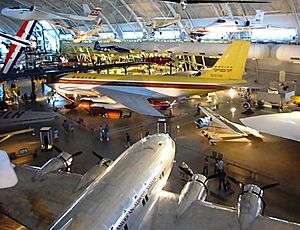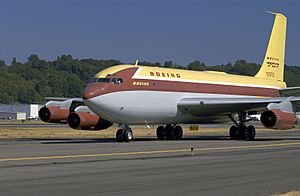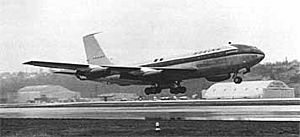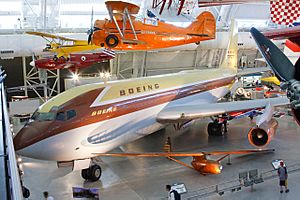Boeing 367-80 facts for kids
Quick facts for kids Boeing 367-80 |
|
|---|---|
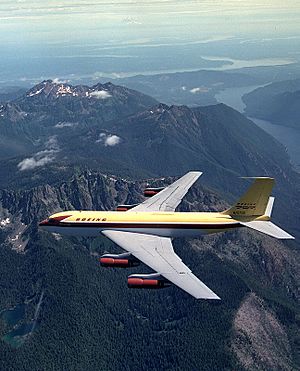 |
|
| The Dash 80 overflying the Olympic Peninsula, Washington, with Mt. Rainier in the background | |
| Role | Prototype transport/airliner |
| Manufacturer | Boeing |
| First flight | July 15, 1954 |
| Introduction | 1955 |
| Retired | 1970 |
| Status | Retired |
| Produced | 1954 |
| Number built | 1 |
| Unit cost | US$16 million (equivalent to $174 million today) |
| Developed into | Boeing C-135 Stratolifter Boeing KC-135 Stratotanker Boeing 707 |
| Other name(s) | Dash 80 |
| Registration | N70700 |
| Owners and operators | Boeing |
| In service | 1954–1969 |
| Preserved at | National Air and Space Museum's Steven F. Udvar-Hazy Center |
The Boeing 367-80 was a special prototype jet plane made in America. The people at Boeing called it the "Dash 80". It was built to show airlines how amazing jet aircraft could be.
The Dash 80 was the first version of two famous planes: the Boeing KC-135 Stratotanker and the Boeing 707. It was built very quickly, in less than two years.
Only one Dash 80 was ever made. Today, you can see it at the Steven F. Udvar-Hazy Center. This museum is located near Washington Dulles International Airport in Virginia.
Contents
How the Dash 80 Was Designed
Boeing decided to create a jet airliner for two main reasons. First, they had learned a lot from building the Boeing B-47 Stratojet. Second, they saw the world's first jet airliner, the de Havilland Comet.
In 1950, Boeing started planning a jet airliner. They called it the Model 473-60C. Airlines were not sure about jet planes yet. They were happy with propeller planes like the Douglas DC-4, DC-6, Boeing Stratocruiser, and Lockheed Constellation.
Boeing had sold many planes to the military. But they were not as successful with airlines. Douglas was the top airliner maker back then. Boeing believed the best way to get airlines to buy a jet plane was to build one and show it off.
Boeing wanted its new jet planes to have different model numbers. Their propeller planes all started with "300." Numbers like "400," "500," and "600" were used for missiles. So, Boeing decided to use "700" for their jets. The first jet would be the 707.
The Dash 80 was 132 inches (3.35 m) wide. Boeing wanted the 707's body to be 144 inches (3.66 m) wide. By the time the 707 was built, its body was 148 inches (3.76 m) in diameter. This change did not cause many delays. The Dash 80 was mostly built by hand.
History of the Dash 80
By early 1952, the Dash 80 was designed. Boeing's leaders gave permission to build it. The Dash 80 was made at Boeing's Renton factory.
The Dash 80 was finished on May 15, 1954. This was just 18 months after building began.
Some problems were found with the engines and brakes. Once, the brakes completely failed when the plane landed. It went past the end of the runway.
The Famous Barrel Roll
Important people from the Aircraft Industries Association (AIA) and the International Air Transport Association (IATA) came to an event. It was the 1955 Seafair and Gold Cup Hydroplane Races on August 6, 1955. The Dash 80 was supposed to fly simply over them. But the Boeing test pilot did two barrel rolls instead!
The next day, the pilot was told never to do it again. However, the pilot said it was totally safe.
Years later, a Boeing test pilot flew the first Boeing 777. This was on June 12, 1994. He was told, "No rolls!"
Used as a Test Plane
After the first 707 was made in 1957, the Dash 80 was changed. It became a test plane for other things. It helped test parts for the new Boeing 727. To do this, another engine was added to the back of the plane.
Last Flight and Museum Home
The Dash 80 was put away in storage in 1969. On May 26, 1972, Boeing gave the Dash 80 to the Smithsonian Air and Space Museum. For 18 years, the plane stayed in a "desert boneyard" in Arizona. Boeing then took it back and fixed it up.
The Dash 80's last flight was to Dulles International Airport. This is near Washington, D.C.. It happened on August 27, 2003. The plane was painted in its original colors. It was then sent to the Steven F. Udvar-Hazy Center. This center is near Dulles Airport in Chantilly, Virginia.
Details (367-80)
Data from Boeing Aircraft since 1916
General characteristics
- Crew: 3
- Length: 127 ft 10 in (39.97 m)
- Wingspan: 129 ft 8 in (39.88 m)
- Height: 38 ft (11.59 m)
- Wing area: 2,400 ft² (223 m²)
- Empty weight: 92,120 lb (41,870 kg)
- Loaded weight: 190,000 lb (86,360 kg)
- Powerplant: 4 × Pratt & Whitney JT3 turbojets, 10,000 lbf (44.5 kN) each
Performance
- Maximum speed: 582 mph (506 knots, 937 km/h) at 25,000 ft (7,600 m)
- Cruise speed: 550 mph (478 knots, 886 km/h)
- Range: 3,530 mi (3,070 nmi, 5,683 km)
- Service ceiling: 43,000 ft (13,110 m)
- Rate of climb: 2,500 ft/min (12.7 m/s)
Related Planes
- Aircraft related to this one
- Similar aircraft
Images for kids
See also
 In Spanish: Boeing 367-80 para niños
In Spanish: Boeing 367-80 para niños


